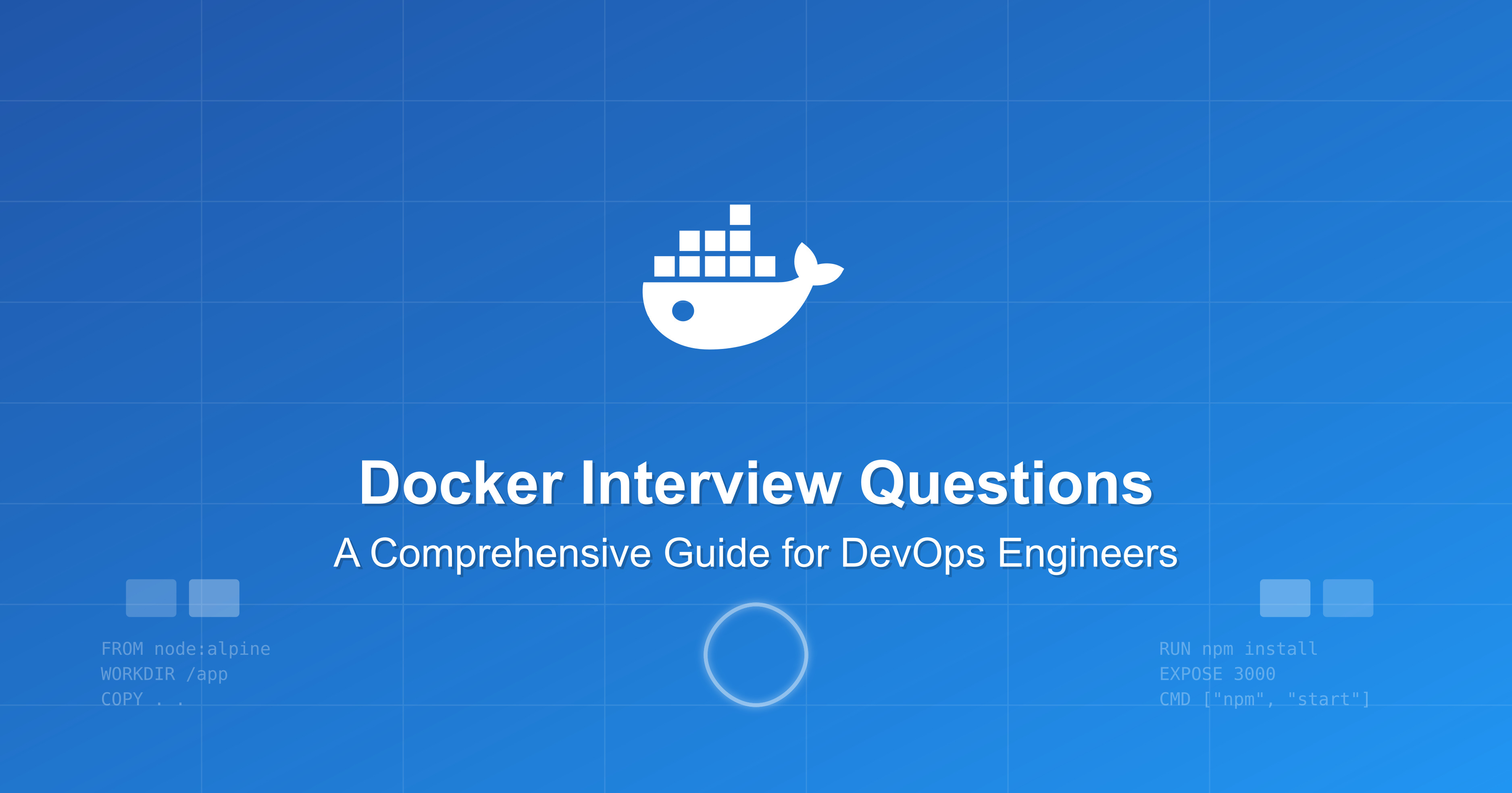Docker Interview Questions: A Comprehensive Guide for DevOps Engineers
 Kanav Gathe
Kanav Gathe
Introduction
Hello there, tech enthusiasts! 👋 Are you preparing for a DevOps interview? You're in the right place! Today, we're going to cover the most crucial Docker interview questions and provide clear, concise answers that will help you ace your interview.
Quick Navigation Index
Core Docker Concepts
Commands and Implementation
Advanced Topics
Troubleshooting and Best Practices
Essential Docker Interview Questions and Answers 🎯
1. What is the difference between an Image, Container, and Engine?
Answer:
Image: A read-only template containing application code, libraries, dependencies, tools, and other files needed for an application to run.
Container: A running instance of an image that can be executed, started, stopped, moved, and deleted.
Engine: The core Docker application that handles building and running containers, including:
Docker daemon (dockerd)
REST API
Command-line interface (CLI)
2. What is the difference between the Docker command COPY vs ADD?
Answer:
COPY: Simply copies files/directories from source to destination in the image
ADD: Has additional features:
Can handle remote URLs
Automatically extracts compressed files
Best practice: Use COPY unless you specifically need ADD's extra features
3. What is the difference between the Docker command CMD vs RUN?
Answer:
- RUN: Executes commands during image build and creates new layers
RUN apt-get update && apt-get install nginx
- CMD: Sets default command and/or parameters for a container
CMD ["nginx", "-g", "daemon off;"]
4. How will you reduce the size of a Docker image?
Answer:
Use multi-stage builds
Minimize layers by combining RUN commands
Use smaller base images (Alpine/slim variants)
Clean up package manager caches
Include only necessary files (.dockerignore)
5. Why and when should you use Docker?
Answer: Use Docker when you need:
Consistent development environments
Microservices architecture
Application isolation
Quick deployment and scaling
Cross-platform compatibility
6. Explain the Docker components and how they interact with each other
Answer: Key components:
Docker Client: Accepts commands from users
Docker Host: Runs the daemon and manages objects
Docker Registry: Stores Docker images
Containers: Running instances of images
Networks: Enable container communication
Volumes: Handle persistent storage
7. Explain the terminology: Docker Compose, Dockerfile, Docker Image, Docker Container
Answer:
Docker Compose: Tool for defining/running multi-container applications
Dockerfile: Script containing instructions to build an image
Docker Image: Template for creating containers
Docker Container: Running instance of an image
8. In what real scenarios have you used Docker?
Answer: Common use cases:
Microservices deployment
CI/CD pipelines
Development environments
Database instances
Testing environments
Application modernization
9. Docker vs Hypervisor?
Answer:
Docker:
Shares OS kernel
Lighter weight
Faster startup
Less resource intensive
Hypervisor:
Complete OS isolation
Better security
Full OS functionality
Higher resource usage
10. What are the advantages and disadvantages of using Docker?
Answer: Advantages:
Consistent environments
Quick deployment
Resource efficiency
Version control
Isolation
Disadvantages:
Learning curve
Security concerns
Performance overhead
Complex networking
GUI applications challenging
11. What is a Docker namespace?
Answer: Namespaces provide isolation for system resources. Types include:
PID (Process ID)
NET (Network)
MNT (Mount)
UTS (Unix Timesharing System)
IPC (InterProcess Communication)
USER
12. What is a Docker registry?
Answer: A storage and distribution system for Docker images:
Public registries (Docker Hub)
Private registries
Stores tagged images
Enables push/pull operations
13. What is an entry point?
Answer:
Configures container that runs as an executable
Specifies the command that will always be executed
Cannot be overridden at runtime unlike CMD
ENTRYPOINT ["nginx"]
14. How to implement CI/CD in Docker?
Answer: Steps:
Write Dockerfile
Build image in CI pipeline
Run automated tests
Push to registry
Deploy to staging/production
Monitor containers
15. Will data on the container be lost when the Docker container exits?
Answer: Yes, by default container data is lost when container exits. Solutions:
Volumes
Bind mounts
tmpfs mounts
16. What is a Docker swarm?
Answer:
Native clustering/orchestration solution for Docker
Manages multiple Docker hosts
Provides high availability
Enables service scaling
17. Essential Docker Commands
Answer:
# View running containers
docker ps
# Run named container
docker run --name mycontainer nginx
# Export image
docker save -o image.tar myimage
# Import image
docker load -i image.tar
# Delete container
docker rm container-id
# Clean up system
docker system prune -a
18. Common Docker practices to reduce image size
Answer:
Use multi-stage builds
Minimize layer count
Use .dockerignore
Clean package caches
Use slim/Alpine base images
19. How do you troubleshoot a Docker container that is not starting?
Answer: Steps:
Check logs:
docker logs container-idInspect container:
docker inspect container-idVerify resource constraints
Check network connectivity
Validate configuration
20. Can you explain the Docker networking model?
Answer: Docker networking types:
Bridge (default)
Host
None
Overlay
Macvlan
21. How do you manage persistent storage in Docker?
Answer: Methods:
- Volumes:
docker volume create myvolume
docker run -v myvolume:/data nginx
- Bind mounts:
docker run -v /host/path:/container/path nginx
22. How do you secure a Docker container?
Answer: Security measures:
Use official base images
Run as non-root user
Scan for vulnerabilities
Limit resources
Use security options
Regular updates
23. What is Docker overlay networking?
Answer:
Enables container communication across multiple Docker hosts
Used in swarm mode
Provides multi-host connectivity
Supports encryption
24. How do you handle environment variables in Docker?
Answer: Methods:
- Dockerfile ENV:
ENV MY_VAR=value
- Runtime environment variables:
docker run -e MY_VAR=value
- Environment files:
docker run --env-file ./env.list
Conclusion 🎉
These questions cover the most important aspects of Docker that you might encounter in a DevOps interview. Remember:
Focus on understanding concepts, not just memorizing commands
Practice with real-world scenarios
Keep up with Docker best practices
Be ready to explain your experiences
Subscribe to my newsletter
Read articles from Kanav Gathe directly inside your inbox. Subscribe to the newsletter, and don't miss out.
Written by
